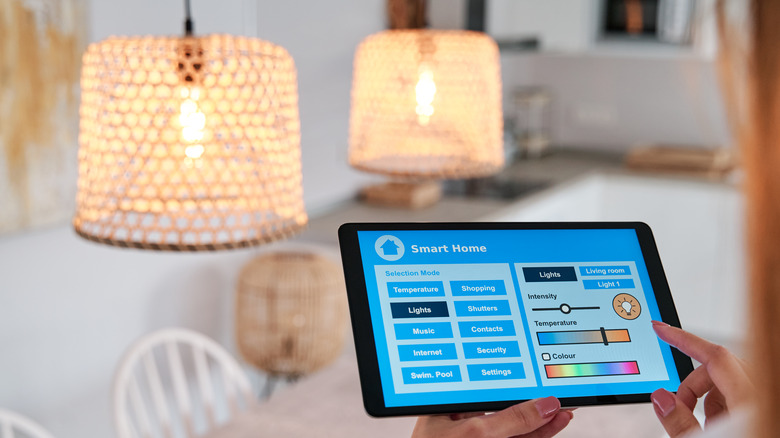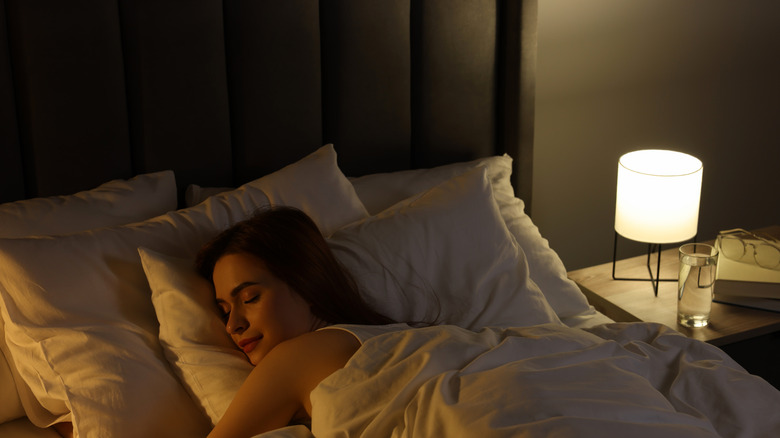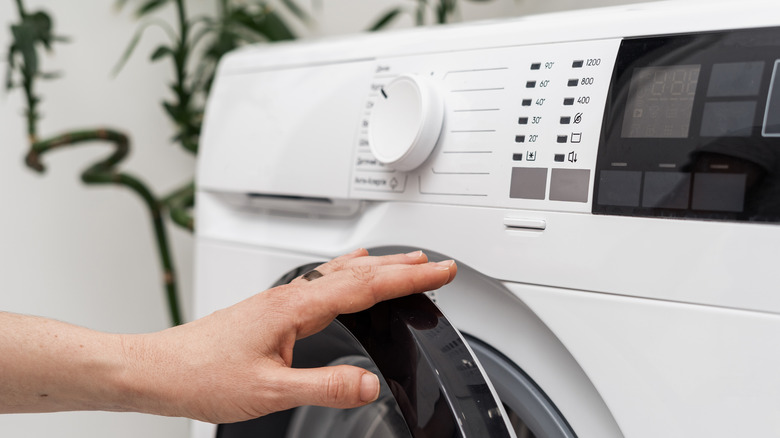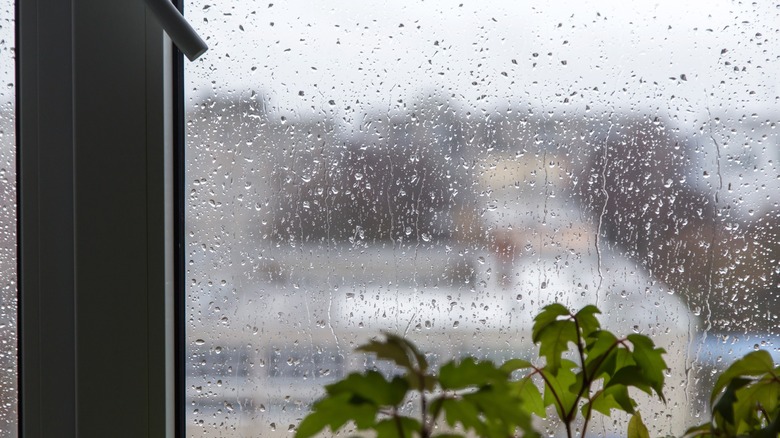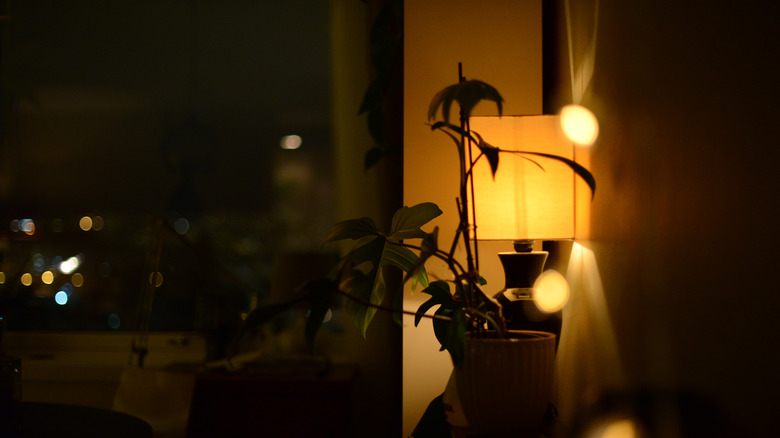5 Unique Uses For Color-Changing Smart Lights
We may receive a commission on purchases made from links.
Imagine how convenient it would be to enter the shower and your bathroom lights automatically turn on. Or going to bed with the dim warm light automatically filling the room for a cozy wind down. That's exactly what smart color-changing lights offer. They're one of the most affordable and easiest to use devices that can transform your house into a smart home.
Many homeowners opt for smart lights over typical bulbs for a number of purposes. One is for mood lighting, where you can set the colors and brightness of your lights to give your space a certain vibe — soft yellow for relaxing or reading, bright pink for a dance party, and more. Then, there's remote-controlled lighting: instead of getting up from the couch and toggling the switch across the room, all you have to do is tap a button on your phone.
However, there's actually more to smart color-changing lights than setting the mood or letting you control it from afar.
Use them as a circadian lighting system
Do you often find it hard to sleep at night and wake up in the morning? If so, you might want to check your exposure to light. Light significantly affects your circadian rhythm — a.k.a. your body's internal clock — which essentially dictates when you should wind down and sleep or be up and running. If you're exposed to bright light two hours before and after your normal sleep schedule, you'll find yourself sleeping later than your bedtime and waking up past your alarm. Similarly, if you're bathed in bright light an hour before and after you normally wake up in the morning, you'll tend to sleep earlier than your bedtime and wake up way ahead of your alarm.
To improve your sleep-wake cycle, you can turn your color-changing smart light into a circadian lighting system for your bedroom. Circadian lighting mimics the intensity, colors, and color temperature of the light outside. This means that in the morning, your smart light should look like a sunrise, starting with a dim purple color with 2,700 to 3,500 Kelvin (K) correlated color temperature (CCT) before fully illuminating to a daylight white with about 4,000 to 10,000K CCT.
This will help you wake up gently instead of abruptly when using an alarm clock. Then at night, your smart light should replicate the sunset. It would display a warm orange color that slowly fades away until it completely turns off and leaves you with a dark room, which is more conducive for sleeping.
Sync your TV and music with your lights
Pairing smart lights with your TV and speaker is actually game-changing. When you sync your color-changing lights with a TV, they can automatically adapt their colors to the color of the content you're watching, making your walls look like an extension of your TV screen. This means your viewing experience won't be restricted to the size of your TV, and you can immerse yourself more fully in the movie or TV show.
For the light-TV sync, you'd want to use two to four color-changing bulbs or lamps whose colors will correspond with each side of your TV. You can also opt for a single light strip that can be placed along the back of your TV. This is easier to install and configure than four individual lights.
Aside from the ability to sync with a screen, some major smart lighting brands like Philips, TP-Link, and Wyze come with a feature that allows you to link your color-changing lights with your audio device of choice (e.g., Bluetooth speaker, headphones). Doing so would make your bulbs or light strips pulse in sync to the beat of the current music playing, changing the lights' brightness and color throughout the song. This functionality can come in handy for setting the mood during yoga sessions and candle-lit dinners, or impressing guests during house parties and holiday gatherings.
Get notified about other smart home devices through your lights
One of the things you should know about smart bulbs is that while they do well on their own, you'll get the most benefit from them by connecting them to the other smart devices in your home network. For instance, instead of constantly checking your phone for an alert about your washing machine cycle, you can just turn your smart light purple to indicate that your laundry is ready.
Same goes for your oven, water leak detector, smoke detector, and even garage door sensor. Configure your light to set the color to green when your baked food is done, blue when water leakage is detected, orange when there's smoke in the house, and red when you accidentally leave the garage door open.
There are also a lot of applications you can do when pairing your smart light with sound detection. If you have a baby in a separate room, you'd probably want a light notification in your bedroom whenever the baby cries. Another application is getting a red blinking light when the sound of glass breaking or carbon monoxide alarm is detected. Motion sensors with smart lights are equally multi-purpose. You can use a motion sensor in your front door to trigger a light in your room every time a guest or an Amazon delivery guy is present. You can also put a motion sensor near the bottom of your bed which will turn on a faint multi-color light strip to guide you to the toilet at night.
Monitor the weather with your smart light
If the weather in your area constantly changes on a dime, then you've probably had enough of opening your weather app every other minute just to adjust your plans for the day. In that case, a visual alert from a smart light might just be the solution for you. Yes, smart lights aren't only good as sunrise alarms or music-responsive lighting. Some smart lights can be programmed to react to your current weather, too.
You can configure them to automatically change to a color of your choice when it's raining outside, and then switch to another color based on the newly detected weather condition (e.g., snow, cloudy, clear). To achieve this, a weather service like Weather Underground or OpenWeatherMap is used to monitor the weather changes. However, if you're using a Tempest Weather System in your backyard, you can also connect it to your smart lights to get more accurate and real-time forecasts.
There are several ways to add a weather-dependent light to your space. You can use it as an always-on monitor for your home office (or any other room you typically stay in), so you can quickly know how your local weather would look like. You can also set it to provide you the weather before you leave for school or work. If you're more of a prepper, there's also an option for the lights to flash tomorrow's weather to get you ready.
Receive visual alerts for scheduled events
Alarms are designed to keep you on time for your scheduled task, whether that's simply going to work, taking your medication, or picking up the kids from soccer practice. Unfortunately, relying solely on audio alarms isn't always effective. You can easily miss it if you're listening to music with your headphones on or if you forgot your phone in another room when the alarm buzzed.
To save you from that headache, why not pair your audio alarm with a visual notification using smart lights? This way, it's easier to notice the alarm going off even when you're doing something else. You can sync your smart light with an audio alarm via a voice assistant like Alexa or using third-party platforms like IFTTT.
You can also opt to use your smart lights as the alarm itself and have it turn on automatically for a specific schedule. For instance, if your kids' bedtime is at 8 p.m., your smart lights in the living room can turn pink at 7:55 p.m., indicating that your little ones need to stop watching TV and prepare for bed. In the morning, the same lights can flash red and blue when it's already time to catch the bus. If you typically follow other schedules in your home — perhaps a garbage collection schedule, bill payment schedule, or a schedule for who should walk the dog — you can configure your smart lights for such purposes too.
